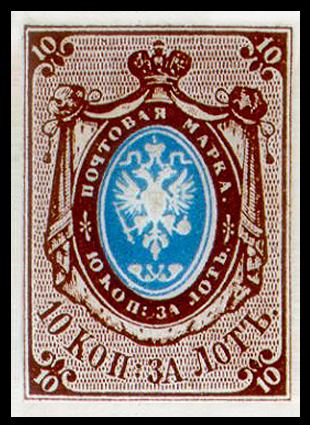Designer Franz Kepler Perforation none | Location of production Saint Petersburg Engraver Franz Kepler | |
 | ||
Date of production 10 December 1857; 159 years ago (1857-12-10) | ||
The first stamp of the Russian Empire was a postage stamp issued in 1857 and introduced within the territory of the Russian Empire in 1858. It was an imperforate 10-kopeck stamp depicting the coat of arms of Russia, and printed using typography in brown and blue.
Contents
History
In 1851, a head of post rail transportation Alexey Charukovsky was sent abroad to study the experience of using postage stamps. After visiting England, France, Belgium, Netherlands, Italy, Austria, Switzerland, and Germany and gathering a lot of information, he returned to Russia in 1852. However, the Crimean War impeded innovations in the postal area. Only in 1855, Alexey Charukovsky filed the Commander-in-Chief of the Postal Department Count Vladimir Adlerberg (1791–1884) a project detailing the activities to introduce adhesive stamps in Russia. According to the Charukovsky's plan, Russian postage stamp had to have a circular shape with a perforation around the picture, and it should have portrayed the coat of arms of the Russian Empire printed in few colours. Furthermore, paper grades had to be protected from forgery. The project was approved on 12 November 1856.
Meanwhile, on 30 July 1856 essays of the first "stempel" stamps were made under the supervision of the head of typographical department of the Expedition of Storing State Papers (ESSP) Jacques Reichel (1780–1857). They were of two design types: the coat of arms of the Russian Empire, and the Mercury head.
The stamps were round in shape. This was because Charukovsky had suggested that a rectangular stamp pasted carelessly on an envelope might catch with its angle on a post box or other letters and peel off. This, in turn, could lead to a return of letters to a sender and required to announce about such incident in newspapers. Each stamp type was printed in four colours: green, blue, black, and carmine. However, these stamps were eventually not approved.
A new design of the first Russian postage stamp, of rectangular shape, was created by an ESSP's senior engraver Franz (Feodor) Kepler who submitted it for consideration on 21 October 1856. Preparing his stamp sketch, Kepler carefully examined all materials brought by Charukovsky from abroad including the original designs and samples of stamps of different countries. As a prototype for creating the Russian postage stamp, Kepler took a printer's sample stamp made by a Prague firm Gottlieb Haase & Sons that was proposed for the Austrian stamps of rectangular shape.
Production
On 20 October 1857, Alexander II approved three two-colour samples printed in denominations of 10, 20, and 30 kopecks. On 9 November, the Emperor ordered to call them "postage stamps" instead of "stempel" stamps. Manufacturing of the 10-kopeck stamps began in November. The first Russian postage stamp was printed on a white hand-made paper with a watermark in the form of a figure "1", 15 mm heigh. Since a punching machine ordered from the Österreichische Staatsdruckerei in Vienna was received only on 19 November and in a state of disrepair, it was decided to hand over a part of the printed imperforate 10-kopeck stamps to the Postal Department for their further distribution to the provinces.
Stamps were produced using two printing presses. One was received from Berlin, and it was used for printing the blue oval with the embossed Russian coat of arms and emblem of the Post Office. The brown frame of the stamp design was printed with the second press.
Circulation
The first Russian postage stamp was officially issued on 22 December [O.S. 10 December] 1857, by the circular of the Postal Department "On the bringing of postal stamps for the common use" that also directed the following:
Starting from 1 January of the next year 1858, usual private letters to all the places of the Empire, the Kingdom of Poland, and the Grand Duchy of Finland brought to the post in usual envelopes or without envelope at all just with addresses written on the letter itself should be sent only with the stamp corresponding to the letter weight.
The stamps went on sale 10 December 1857, but officially people started to use them to pay internal correspondence in Russia on 1 January 1858, and on 1 March 1858 in the Caucasus, Transcaucasia, and Siberia. Since then, all private letters had been sent only with postal stamps that were cancelled with two crossed lines. This was because supply of the numerous post offices with postmarks took a while and the Postal Department ordered to cancel stamps with pen and ink following the previous practice of cancelling stamped envelopes.
The first stamp value of a 10-kopeck had to be used for letters weighing up to one lot (about 12.8 grams). This was followed on 10 January by 20-kopeck and 30-kopeck perforated stamps using the same design but in different pairs of colours, along with a perforated version of the 10-kopeck stamp. The paper was originally watermarked with the numeral, but this was soon abandoned, and later printings in 1858 are on regular wove paper.
Commemoration
Postal authorities of the Soviet Union and now Russia (Russian Post) repeatedly made issues of commemorative stamps, miniature sheets, postcards and other philatelic items. Stamp exhibitions and other memorable philatelic events have also been organised. Research on the history of the first stamps of the Russian Empire is a subject of numerous publications including newspaper and journal articles and books.
